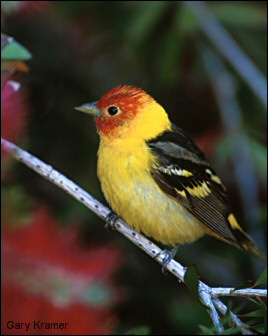
As everyone knows, it's the squeaky wheel that get the grease. This implies that you have to be a bit of a loudmouth if you want to draw attention to yourself, and certainly, there's a considerable amount of truth in this. However, attracting attention can also have its drawbacks, such as being "volunteered" for various chores or even setting up yourself for verbal or physical attack.
Things aren't all that different in nature, where some kinds of
birds have males who are brightly colored to attract the females of the
species—the visual counterpart of the loudmouth. And conspicuous coloration does
indeed attract the attention of the females. But, as among humans, there's often a
price to pay. A recent study indicates that such advertising also attracts
predators--so much so that local populations of species that have brightly colored
males are about 25% more likely to die out than kinds with inconspicuous males. So next
time you see one of our brightly colored Chihuahuan Desert birds, keep the
memory—they just might not be around next year.

Contributor: Arthur H. Harris, Laboratory for Environmental Biology, Centennial Museum, University of Texas at El Paso.
Desert Diary is a joint production of the Centennial Museum and KTEP National Public Radio at the University of Texas at El Paso.

Male Western Tanager. Photograph by Gary Kramer, courtesy of U.S. Fish and Wildlife Service.